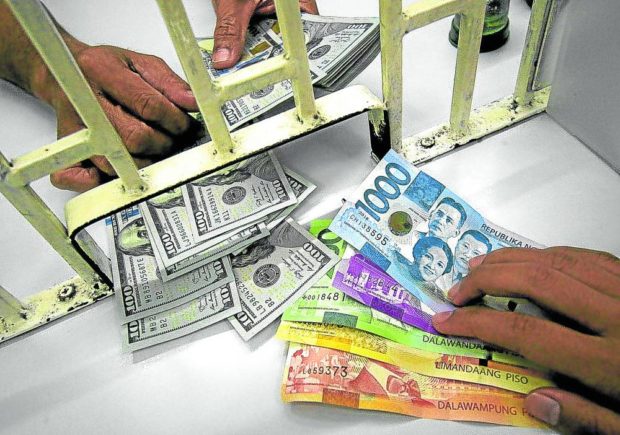Peso to further weaken as trade deficit widens

FALTERING PESO | A customer transacts with a money changer in Manila. The peso is expected to weaken to 53.50:$1 by June. (FILE PHOTO)
MANILA, Philippines — The Philippines peso is expected to weaken to 53.50:$1 by June amid the widening trade deficit, although the local currency is seen gaining strength for the remainder of the year.
According to the Netherlands-based ING Bank, the Philippine trade deficit was expected to have expanded to $4.9 billion in March, widening by two-fifths from $3.5 billion in February and by four-fifths from $2.7 billion in March 2021.
England-based Pantheon Macroeconomics expects $4.7 billion while HSBC believes it will reach $4.4 billion.
“Philippine imports should sustain the trend of double-digit gains, driven by an expected surge in fuel imports given elevated global crude prices,” ING Bank said in a commentary.
With the trade deficit remaining “sizeable” in March, this would exert depreciation pressure on the Philippine peso in the near term, the Dutch bank said.
Pantheon Macroeconomics believes that the peso will reach this year’s bottom value in June, falling from 51.80:$1 at the end of March.
However, the peso is then expected to strengthen to 52.50:$1 in September and further to 52:$1 by December.
“The [trade] deficit likely returned to [the January level of] $4.7 billion in March, after rising [narrowing] to $3.5 billion in February, when Lunar New Year effects hit imports substantially,” Pantheon Macroeconomics said.
Exports growth
The research firm noted that the growth of Philippine exports likely crashed to negative 0.3 percent year-on-year from 15 percent in March 2021, due mainly to an adverse base effect.
The growth in imports also faced the handicap of a high base number but the jump in inbound shipments of commodities likely revved up growth to 20.5 percent from 20.1 percent.
“As the Philippines is a net importer of both food and fuel, it remains susceptible to upside risks of inflation,” HSBC said, adding that inflation may have heated up to 4.6 percent year-on-year in April.
“While fuel subsidies already exist in the Philippines, the government may also cut taxes on food imports and use targeted subsidies to tame food prices,” HSBC said. “These measures should help offset some of the price pressures in the coming months.
Accelerating inflation
ING Bank expects an even hotter inflation figure at 4.8 percent, prompting it to reiterate that the latest numbers should convince the Bangko Sentral ng Pilipinas to turn hawkish and raise its key policy rate before the end of the second quarter.
BSP Governor Benjamin Diokno earlier said the central bank might consider raising interest rates in June, especially if the Philippine economy grew by 6 percent to 7 percent in the first quarter.
Official data on external trade and inflation will be announced later this week and on the gross domestic product next week.
RELATED STORIES
UK think tank: Oil price spike to hike PH inflation, widen trade deficit
